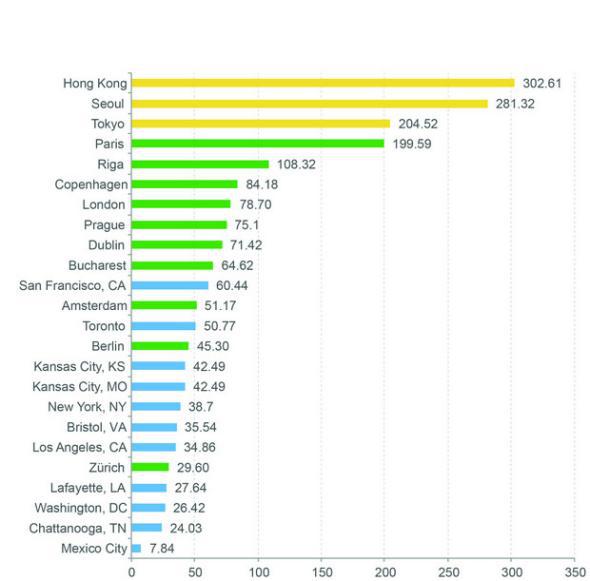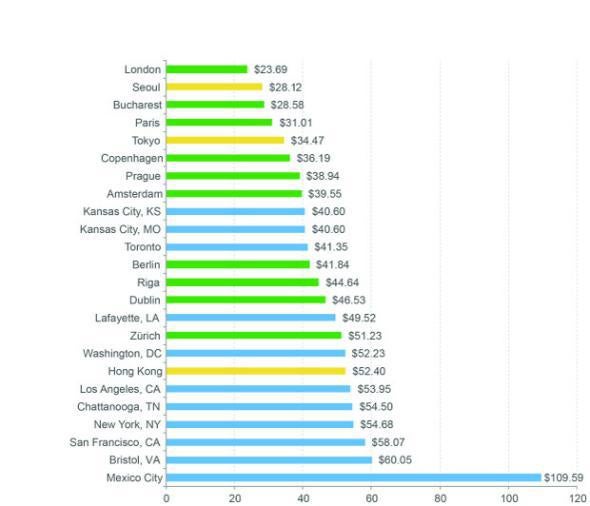You’ve probably looked at your monthly Internet bill and groaned, thinking that it was far higher than it should be. Well, you were probably right. It turns out that if you live in New York City or San Francisco, you could be paying more than twice as much as a customer in Paris or London for a considerably slower broadband Internet connection.
It’s no secret that when it comes to speed and price, U.S. broadband options often pale in comparison with some of the great deals available in other cities around the world. We know that cost is one of the key barriers to adoption for unconnected Americans, and that Internet service providers rank at the very bottom of consumer satisfaction surveys, below the airlines and health care industry. But a recent study by New America’s Open Technology Institute provides more data about what the American broadband market looks from the customer perspective. “Cost of Connectivity” documents the actual high-speed Internet packages available in 24 cities around the world, giving you a glimpse about what, for example, a 25 Mbps connection costs if you live in Los Angeles, London, Hong Kong, or Kansas City. And the results are not very pretty. (Disclaimer: I am one of the authors of the study, and Future Tense is a partnership of Slate, New America, and Arizona State University.)
With information on more than 2,000 home and mobile broadband options in 24 cities scattered across North America, Europe, and Asia, “Cost of Connectivity” shows where the fastest speeds are available, the best deals you can find for less than $40, and what you might expect to pay, on average, for a given speed tier in each of the cities surveyed. Some of the contrasts are stark. In Seoul, Hong Kong, Tokyo, Paris, and Bucharest, $40 a month will buy blazing-fast gigabit service—while in Los Angeles or New York, a Time Warner Cable customer would the same price for just 15 Mbps. Meanwhile, 3 GB of data costs at least $30 in the United States, but for roughly less than $10 you can get 6 GB in Copenhagen or Bucharest.
This reality is illustrated quite clearly when you look at the quantitative relationship between speed and price for the home broadband data, which allows us to estimate what you’d expect to pay for 25 Mbps in a given city, or what you can expect to get for $50. Notice that all the blue cities (which represent North America) tend to be clustered on the high end for price and low end for speed. You can expect to pay more than twice as much for 25 Mbps (a speed which FCC Chairman Tom Wheeler recently described as “table stakes” when it comes to broadband in the 21st century) in the United States compared with parts of Europe and Asia. And $50 goes 10 times further in Hong Kong or Seoul than Washington, D.C.

Chart from “Cost of Connectivity”

Chart from “Cost of Connectivity”
Now in its third year, the annual “Cost of Connectivity” survey is just one of a number of studies that compare different aspects of the global broadband market. Some, like Akamai’s “State of the Internet” report, measure actual speeds delivered in countries all over the world. The United States doesn’t crack the top 10 in the Akamai rankings, either, delivering an average connection speed of 11.4 Mbps (compared with South Korea, which tops the charts at 24.6 Mbps). Others, like the Organisation for Economic Co-Operation and Development’s broadband portal, compare various price “baskets” in the 34 OECD countries. For speeds of 15 Mbps and above, the U.S. ranks 26th overall. Taken together, it’s clear that while speeds and prices in the U.S. are improving overall, we aren’t necessarily matching the pace of peer countries on these metrics.
To make things worse, despite how much you might be paying for your home Internet connection, new evidence suggests that you may still be experiencing degraded speeds on some of your favorite websites and services if you’re one of millions of customers who appear to have gotten caught in the middle of ISP interconnection disputes in the past year and a half. So, even if you’re paying through the nose for a high-speed connection, your video could still buffer or fail to load as your ISP negotiates for additional fees from content providers like Netflix.
At the end of the day, this is about much more than what it costs to stream movies online. As Internet access becomes more and more essential to our everyday lives, a high-speed connection looks less like a luxury than a necessity. So high Internet costs translate into difficult budgeting trade-offs for households that struggle to cover the costs—and an ongoing barrier to adoption for those who currently aren’t online because they can’t afford it.
